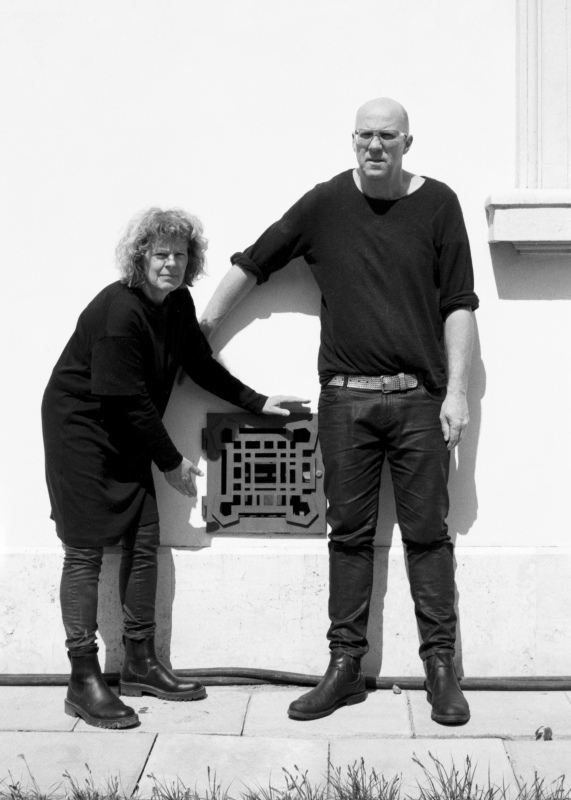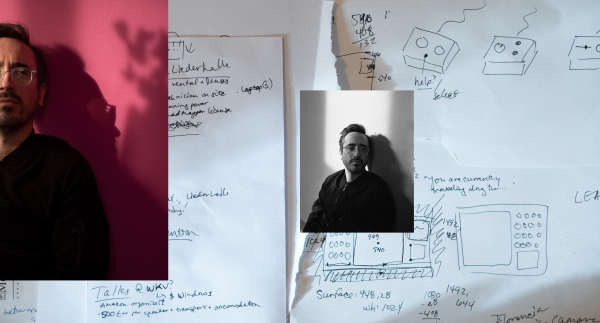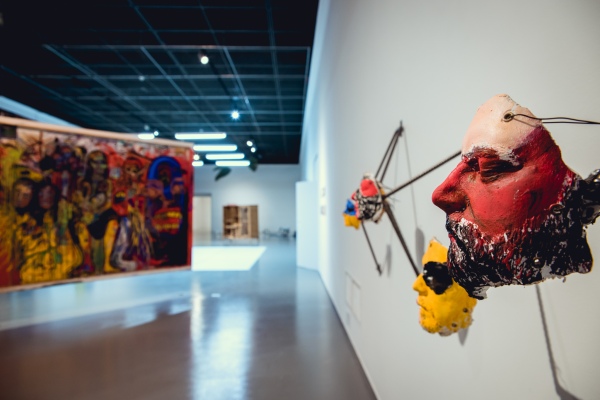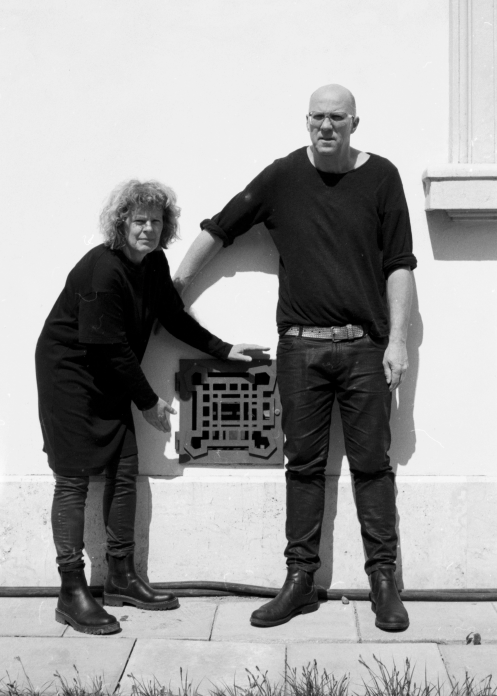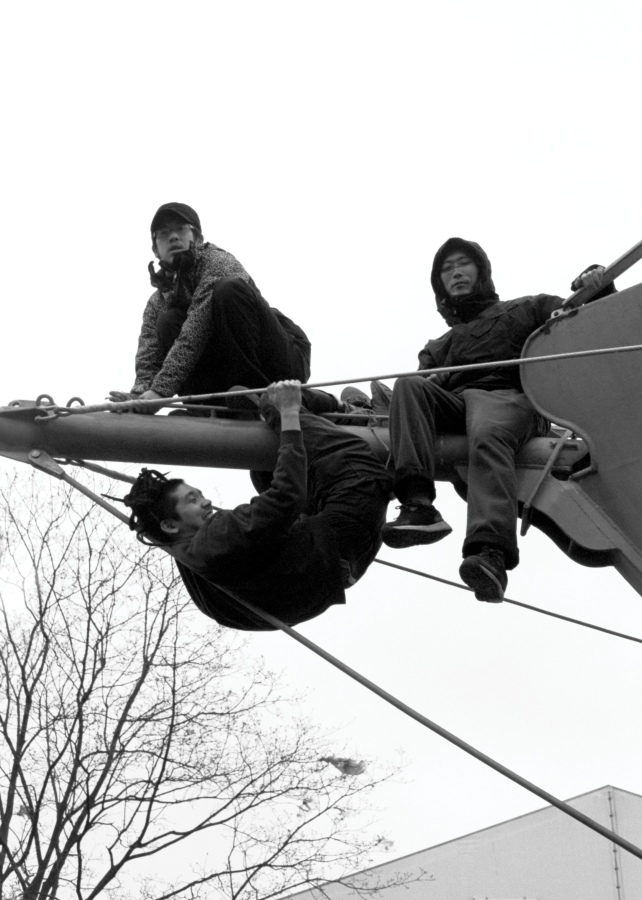Too much to fit in an institution
Liesbeth Bik and Jos van der Pol from the Dutch collective Bik Van der Pol, interviewed by Agnieszka Sural about usability, site sensitivity and adding what is missing. During their residency in Warsaw, they worked on an exhibition of the collection of the Ujazdowski Castle Centre for Contemporary Art
-
Agnieszka Sural: You have been collaborating since 1995. How has the art world changed during that time?
- Bik Van der Pol: In the 1990s, the art world was still relatively small. It was basically dominated by Western Europe and the United States, with not that much communication with or interest in other art worlds. This essentially meant that other art worlds did not exist in the perception of the Western world. After the wall that had divided Europe fell in the early 1990s, everything cracked open: capitalism accelerated, travel and interests also accelerated, and the art world became more global. Just like the economy, pushed by capitalism and the global market. So as a result of these dynamics, Chinese, African, South American and Central European cultural worlds have become more visible.
-
You have worked before with collections in France and South Korea.
- We worked with the collection of FRAC Nord-Pas de Calais in Dunkirk [ed. FRAC: Fonds régional d’art contemporain / Regional Fund for Contemporary Art]. That was in 2002. We were asked to develop a new work and make a solo show of our existing work in the FRAC space there, and also to work with their collection. The point of departure of all the FRACs in France is that their collections should always travel, to continuously be brought to the people, as these collections are a ‘public good’. We brought the collection to TENT, a contemporary art space in Rotterdam. The transportation of the works was sponsored, so we were able to bring 150 works to Holland.
-
What was your working method?
- The FRAC collection consisted of about 650 pieces. When we visited their storage space for the first time, we thought it was very inspiring. The crates of artworks were full of labels, with names and addresses. So one could see where the various pieces had travelled to and been exhibited worldwide. The boxes open up as much an imagination as the art works inside them. After a lot of thinking and trying out the many possibilities that we could explore, the premise for selecting a work became the discussion that a piece inspired between us. Some pieces might be less interesting by themselves, but they nevertheless played a role in our discussions. Sometimes a work had been very influential on our own thinking, sometimes we knew a work from hearsay or from books only, and then found it in the collection. So we grabbed the chance to finally see such works for real.
- Based on this, we made a pre-selection of 150 works and then asked ourselves: what would this choice mean for other people? We invited nine groups or individuals: artists, writers, curators, a filmmaker, a group of architects, a chef – among them Polish artist Paulina Ołowska who teamed up with American artist Jill Magid. We asked them to make their own selection from our selection. It was important that the people we asked would be able to justify and talk about why they felt a collection is important, and why they were interested in the works they had chosen. We interviewed them about their choices and interests, and about the meaning of a collection, both for themselves and for history. These interviews were presented in the exhibition space on small monitors. Since we had one month for this exhibition, we divided the month into nine short periods. There were nine different shows, each of up to four days. In one of the spaces, the 150 works were exhibited in their crates, and in the other space the works were displayed.
-
The title of the exhibition was Married by Powers. What does that mean?
- The project is about delegation and trust. The director of FRAC invited us to work with their collection. Then we asked others to make a selection from our selection. The title somehow represents this, but comes from another situation. If you want to get married with somebody who, for example, lives in Argentina, and you are not able to travel there to be in the same place at the same time, you can be legally married at a distance. This is called Married by Powers. This emphasised the aspect of delegation and trust.
- We also chose three works that were displayed during the whole period; all works that embodied ‘dialogue’. These were Speech Bubbles by Philippe Parreno, Rirkrit Tiravanija’s lounge with a couch, a fridge filled with soda and a table football, and Andy Warhol’s print on the wall. The public could play football there, hang out, open the fridge and drink. There was also a work of Tony Oursler, a small video projection of a face shouting to the public.
-
You used the same title when working on a collection of the SeMA in Seoul. Did you have the same concept?
- This was in 2016. When we did Married by Powers at the SeMA, it was completely different, though the concept and method was similar. SeMA has 6000 works and in most cases we were not familiar with these works or artists. We knew some artists in the collection, but not much about the South Korean context.
- We had a good relationship with Jin Kwon, the curator at the museum. We had many long discussions, and then she made a pre-selection based on these conversations. She also proposed nine people who would make a selection from our selection, including an artist, a writer, a theatremaker and a filmmaker. A cross section of people who would be interested and willing to speak about art works and practices, and who could articulate their choices. We interviewed them and presented their choices in the space of the show, again in an alternating series of installed shows. This time, all the works not on display would form publicly visible storage, fully displayed in the exhibition space of the museum, next to the space where the selections were exhibited.
-
What is the process of working on the collection in Warsaw?
- We wanted to meet a lot of people connected with the history of the Ujazdowski Castle Centre for Contemporary Art, such as Piotr Rypson and members of the Akademia Ruchu. We wanted to learn about the history of the place, the collection, the ‘heroic years’, as many people called the 1990s, and about the changes the Centre has been through. We needed to find out, from various perspectives, about Wojciech Krukowski, Fabio Cavalucci, and others involved. We came to understand the importance of Akademia Ruchu for the way the Centre developed conceptually. We also spoke with Janusz Bałdyga, a member of the AR. We spoke with curators, educators, people who used to run the café as well as people who lived in the Castle. To hear the different voices around the history of the Castle. In our observation, this is an institution that has gone through many stages of life. For example, Krukowski’s times were known by some as the ‘heroic years’ and were considered or remembered as very exciting. We wanted to know why.

- Liesbeth Bik and Jos van der Pol at the library of the Ujazdowski Castle Centre for Contemporary Art. Photo: Dawid Misiorny
-
How do you perceive the Ujazdowski Castle’s collection?
- The collection of the Ujazdowski Castle Centre for Contemporary Art is not so much a collection as an archive. Learning more about Krukowski’s time, we understand how he and the curators have built up a collection that is not really a collection. It is more a historical timeline – an archive, where artworks, documents, leftovers, and letters can be considered as ‘props’, actors in that timeline. Some works ended up here by coincidence; some pieces were given and some artists were asked to donate their works. Most of the artists agreed, but the documents proving ownership are not always there to prove this. This was common practice in the 1990s. Those years were much more informal, there was a lot of improvisation and a lot was based on trust, relationships and friendships. And that is all pretty exciting.
- We have tried to work with these issues, but we are not interested in copyrights. We have attempted to see the output of the institution as an archive, and the objects are part of that. We will show some works and write scripts based on our interviews with several people. There will be many voices in the space. We will also work with performers on a choreography in relation to the script and the displayed works. One of the sources of inspiration is the methodology of the Akademia Ruchu, as we see this as a base for the Castle’s concept as an institution.
- The works that we will choose for the show we call ‘markers’. Each piece says something about history of this institution and is an important reference point for the past, present and future. One example of this is Lawrence Weiner’s piece Far too many things to fit into so small a box, once on the facade of the Castle, now covered with paint after renovation works.
-
Would you want to recover it?
- Apparently there were talks with Lawrence Weiner and he agreed, in principle, to it being put back. Then his wife, who is responsible for the works, told CCA that the work had been sold.
- This work is important for us because it says a lot about the collection/archive and the stories around it. It is too much to fit in an institution. This is not only about the space itself, but also about the energy of the people. There is a lot of excitement, anger, frustration and memories. It is like in real life. The whole archive is too big and too complex to fit into a small box. There is a list of works, there is no list of works, there are works that can be shown, and those that cannot be shown, works that are secret, works that have fallen apart, works that were found in bushes.. We have heard interesting stories.
-
In October your show will open at the Ujazdowski Castle. Which works are you going to present?
- Most likely we will show works of the Akademia Ruchu – mostly performances, perhaps The Essay. This is interesting because it is about public responsibility. Krukowski gave a public talk about what they did over the last 12 years, and then he asked the Akademia Ruchu to perform it. It is an interesting methodology in relation to what we are producing now. Another interesting document in the archive is a video talk between Milada Ślizińska and Barbara Kruger. We can see two women at the bottom of the screen, but the majority of the image is just a projection with works by Kruger. When Milada starts to translate all the artist’s posters into Polish, Barbara asks to not be in the image because it is distracting. The rest of the film is just a white square. It is a very funny situation. Then when they talk, some of the reactions from the public, mostly men, start to become quite aggressive.
-
Speculating about the future, climate change reports say that human civilization will collapse in a few decades. Where will Bik Van der Pol be in ten years?
- Maybe it would be better if we were not in Rotterdam, because large parts of the Netherlands are below sea level already. It is hard to imagine what will happen due to climate change. It is a long- and short-term issue at the same time. Long-term because of the slow and likely collapse on a global scale, but then there is the everyday, what you could call forms of civilisation. We have just learned that the Museum Boijmans Van Beuningen in Rotterdam will close its doors for seven years due to renovation works. As a result of this, a whole generation of kids will not get to experience the art from their collection, and will perhaps not be touched by any art. This will affect their relationship to art, as well as their affinity with it. And it will change their capacity to develop their imagination, in a time when we increasingly need more unorthodox forms of imagination.
- We live in very strange and radical times. If we think about climate change, maybe it would be best to get as high up as possible, as that will save you from the worst. Let’s say the coastlines of Great Britain and the Netherlands will collapse, rivers will dry up, forests will be on fire, people will migrate to the Northern parts of the planet and the global economy will fall apart. You could perhaps say: I would like to be on a mountain in Switzerland, but actually it doesn’t matter where one will be. We will see the best and the worst in people come to the fore in a situation where nothing else is at stake than to save their own lives. Lawrence Weiner’s work Far too many things to fit into so small a box could be seen as speaking to this as well.
Film: Marta Wódz
